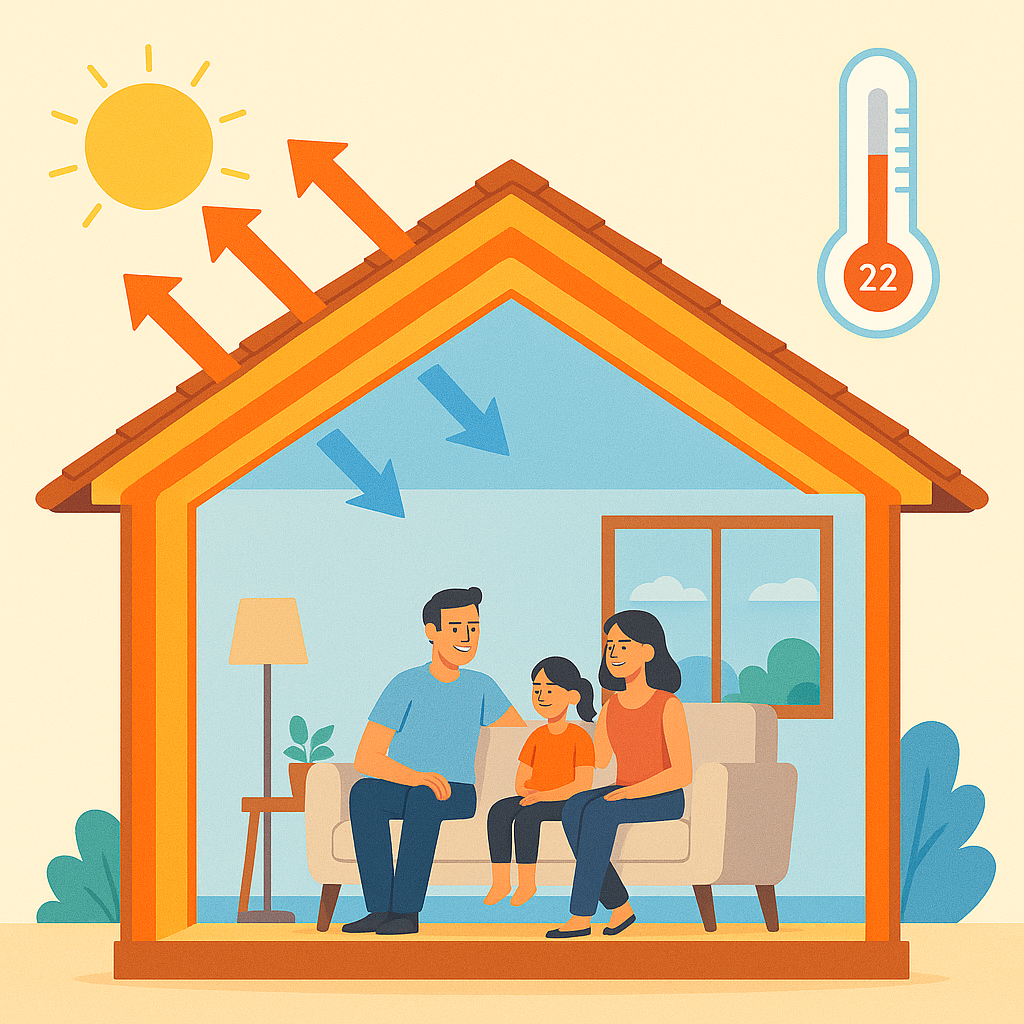Domestic life has changed exponentially throughout time – from how we cook and clean, to how we socialise and enjoy our spare time – our habits are ever-changing as technology and human behaviour evolve. But how has home heating developed to reach the technologically-advanced processes we used today? Read on to find out more about the history of home heating.

In the Beginning…
Humans have always needed a source of heat to survive, which in the early days of man would have been fire. As far back as 1.5 million years ago, fire would have been the lifeblood of our earliest ancestors once they learnt to use it to their advantage. Not only was fire a valuable heat and light source used to survive the brutal winters, but it also would have been used to cook food, craft more advanced hunting tools and provide protection from predators (especially at night). Fire was continually used in this way for thousands of years, until eventually it was transported into early forms of the home, where an opening in the roof acted as a funnel for the smoke to escape.
By 2,500 BC, fixed hearths began to emerge – fragments of which have even been found during excavations in certain areas of Greece. By 1,500 BC, the ancient Egyptians became accustomed to using bellows after discovering that they were an effective method of safely fanning flames and increasing heat levels. In the Middle East, as early as 1,300 BC we can even see the very first use of a popular selling point of homes today – underfloor heating – which was built into King Arzawa’s Turkish palace.
The Roman Period
Notorious for being history’s innovators, it is thought that the Romans were the first to invent a very basic form of the central heating system we are familiar with today in around 100 BC. Improving upon the ideas of early humans by implementing heating into their floors and walls, Roman central heating consisted of gaps beneath stone floor slabs, known as hypocausts. The floor was reinforced by pillars over a chamber that had a fire at one end, which allowed the heat to travel below the floor and to the other side. A system whereby heat generated in a single location is dissipated throughout a property? Sounds like central heating to us!
Of course, not everyone would have had the luxury of benefiting from this early system, which eventually advanced to include hollow tile walls to better heat the entire room. Only the upper echelons of society, as well as visitors of the public baths, would have been likely to make use of it. When the Roman Empire fell, their central heating technology fell into disuse and households resorted to fireplace heating for centuries afterwards.
The Dark Age
In around 800 AD, clay stoves started to make an appearance, and large buildings – such as the Luneburg in Germany and Rueda Abbey in Sastago, Spain – were partly responsible for the revival of the art of central heating through the use of indoor furnaces. However, it was the invention of the chimney in the 12th century that really helped the notion of indoor heating to take off again after the demise of Roman civilization. The first ever chimneys were designed to house a sweep inside for cleaning purposes, meaning that they were much wider than more modern iterations. The earliest known instance of a chimney in England is at Gainsborough Castle in Yorkshire, built in 1185.
The 17th & 18th Centuries
Despite the fact that home heating advancements were few and far between during this time period, there were still some developments that paved the way for more significant breakthroughs down the line. In the 1600s, for example, Louis Savot created a type of ‘circulating fireplace’, consisting of a raised grate that enhanced indoor air circulation. Later, in the early 1700s, the use of combustion air from an outdoor duct grew in popularity as a way to heat the inside of buildings across Europe. Russia’s monarch at the time, Peter the Great, even had a hot water and air-heating system installed in his infamous Summer Palace. As the century advanced, Scottish inventor James Watt built the world’s first steam-powered heating system, which functioned via a central boiler and a network of pipes.
The Victorian Era & the 19th Century
The 1800s is where things really started to heat up technology-wise. In England, William Strutt came up with a furnace that warmed air as it travelled through a series of ducts and rooms that would heat his mill in Derby. In his design, cold air was channelled from outside through an underground passage before being heated in a large stove. The warm air would then emit through central ducts and across the building. Strutt’s novel heating system was such a success that he later collaborated with an engineer called Charles Sylvester to help heat Derby’s Royal Infirmary Hospital. This is perhaps the most notable point in the history of home heating that we’ve come across so far, as it sparked an exploration into creating a heating system that produced fresh, healthy warm air that was free of contaminants.
In 1875, Franz San Galli from Russia designed the first radiator, which was constructed using large columns of steel through which hot water would run and heat air that emitted into the room. However, like many new inventions that came out at the time, it was completely unaffordable for the masses and most people continued to burn wood or coal on open fireplaces. However, widespread domestic use of electricity was just around the corner.
Although it is contested, American inventor Thomas Edison is generally credited with the invention of the electric heater in 1880; around the same time that the first thermostat became available. In the UK, we were also making waves in the electrical heating department. In 1891, Herbert John Dowsing displayed an electric cooking appliance at the Crystal Palace Electrical Exhibition and went on to devise heaters for domestic use that were effective at radiating warmth outwards through the room.
20th Century
Despite advancements in the 19th century, electric heaters tended to be precarious safety-wise, with extremely hot parts left unguarded. In fact, it wasn’t until the 1950s that electric bar heaters became more safe to use, and in the 1960s electricity use soared in the UK – although this had its drawbacks. Power stations couldn’t be powered down at night when consumption was at its lowest, and thus a solution was required to increase usage during this timeframe. As a result, storage heaters were launched that recharged overnight, after which the user could turn it on as usual during the day.
Central heating started to take off in the UK in 1970, though the average family wouldn’t typically have had a radiator in their home – generally only the very wealthy would have benefitted – and solid fuel was still commonly used on an open fire to heat rooms and water. By the 1980s, however, central heating was commonplace, and led to a shift in health and wellbeing, home design and even homeowners’ behaviour. For example, warmer homes meant a reduction in winter mortality rates, a more lightweight dress code in the home and the building of larger sitting rooms and open-plan kitchens that weren’t too cold to enjoy.
The Future of Home Heating
The way in which we warm our homes is constantly evolving alongside our understanding of technology and home design. Better comprehension of safe and efficient heating elements has led to an increased availability of effective electric heating systems, while apps and smart technologies now allow us to control our home’s temperature even when we aren’t there. Timers and LED screens provide us with complete control over exactly when and for how long our rooms are heated, and a concerted nationwide drive towards green energy has reformed the power sources we lean towards.
As we continue to push for more energy efficient, sustainable sources of heat, ensuring that these options are accessible to everyone is paramount. Government backed schemes such as the ECO4 grant aim to support low-income households by providing them with low-cost, high-efficiency heating and insulation solutions. Targeted at properties that fall within the efficiency bands E, F and G, the grant can be used to install or upgrade cavity wall insulation, central heating and loft insulation. All of this is provided free of charge by the ECO4 scheme, but this isn’t the only benefit. With huge volumes of heat getting lost through poor insulation, using this heating grant will save you money on your bills each month.
If you believe you are eligible for ECO4 heating funding, our dedicated team here at UK Energy Management will support you through the application process – from checking your eligibility to enrolling you in the scheme, to ensuring all of your energy-efficient home improvements are carried out by qualified tradespeople and installers. There’s no catch: simply check your eligibility with us, and if you fall within the criteria then we’ll take care of the rest. To find out more about what we do, please get in touch.



